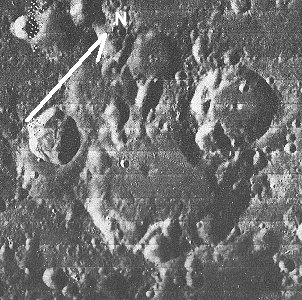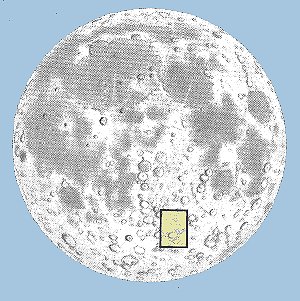

I would like to report a sunrise ray I observed in the crater Gemma Frisius.
On Friday July 7, 2000 at approximately 7:00 Eastern Standard Time I was observing the moon at the terminator. I have a 20" obsession dobsonian and was observing at my parents house which is north east of the city of Toronto, Ontario in Canada.
I was looking at the Gemma Frisius crater and I saw a triangle of light that according to Rukl map #66 of his atlas, started at the middle of the crater on the eastern side and then forming a triangle that got wider as it went to the western side illuminating 2 or 3 small craters in the floor of of the crater. The triangle of light was not ordinary light illuminating the crater floor. Tt was very thin and shadowy and seemed to hover over the crater. Tt was visible for about a half hour, but it may haxe been visible for awhile before I saw it. This ray was so obvious that it stood out. Anyone with a telescope would have seen it.
I did not know what it was at the time, so I assumed it was a common occurance and didn't study it to death. This triangle of light was also witnessed by my mother Phyllis Stratton who also confirmed it. It appeared as light coming through a hole in the crater wall and shining like a flashlight into the crater. When I went to the description in the atlas about the crater it says it has a broken wall, which puts all the pieces together.
Another strange thing I saw was two bands of darkness in the triangle which were perpendicular to the triangle almost like dark bands in a spectrum of a star. They were spaced fairly evenly out in position in the triangle. They seemed to be almost part of the light ray triangle. I thought the bands were hidden details on the crater floor that the ray was illuminating, but when I looked at the chart there was no correlation.
I am wondering if anyone else witnessed this sunrise ray, and also if you have seen these bands in other sunrise ray events, and finally do you know what they represent?thanks,
Ephemeris For 2000/ 7/ 7 at 23: 0 U.T.
Site Longitude: 79.383 J.D. 2451733.45833
Site Latitude: 49.650 Sun's Alt. 20.49° (Daylight)
Site Elevation: 250 meters Moon's Alt. 41.43°
Earth's Selen Sun's Selen Frac ------- Topocentric -------
Long Lat Colong Lat Illum Phase Distance Semi-Dia HP
° ° ° ° Angle° kms " '
7.49 -6.56 345.55 -0.24 0.440 96.6 376,348.29 952.55 57.29
-------- moon's --------- perigee date/ apogee date/ anomalistic
r.a. dec. parallax parallax phase
12h 41m 15s 1° 6' 7" 2000/ 7/ 1 22:20 2000/ 7/15 15:35 0.273
61.36' 53.98'
Moon's Age P.A. of Axis
(d) °
6.151 23.54
GEMMA FRISIUS, +187 -562 [Dutch scientist, 1508-55]. A great formation about 80 miles in diameter, with irregular walls, broken in places by craters ; on the northwest a large formation, Goodacre, intrudes. The western wall is tolerably even, and commences on the north at a crater, east of which-on the floor of Gemma Frisius-is a partial ring, D. A large ring abuts on the outer south-west; this is known as A, and has a remarkable crater group on its inner east slope. On the south crest of Gemma Frisius is a crater-chain. East of this the main wall runs in a bold sweep to the northeast, where its continuity i.s destroyed by the intrusion of two large rings, both open on the south, so that their interiors are in communication with that of Gemma Frisius. The larger of these rings, H, has very broad walls. On the floor of Gemma Frisius is a nearly central hill, as well as some craterlets and a dark spot on the west. On the outer east is a large enclosure, G, with two overlapping rings, D and K, at the end of the south wall-which is prolonged, and with a gap between it and the wall of Gemma Frisiust The ring, D, has a central peak. On the outer south-east there are many craters. The Moon, by Wilkins and Moore, 1955, Faber & Faber Ltd, London p.142

